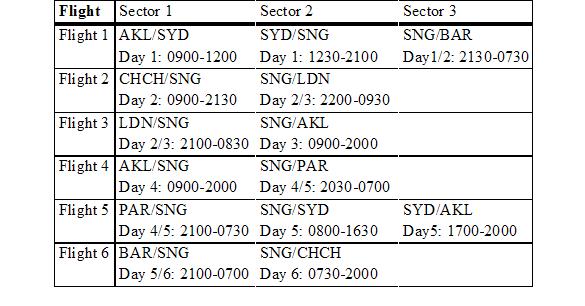
Difference: AirCrewRostering (4 vs. 5)
Revision 52008-03-01 - TWikiAdminUser
| Line: 1 to 1 | |||||||||
|---|---|---|---|---|---|---|---|---|---|
<-- Under Construction --> | |||||||||
| Line: 26 to 26 | |||||||||
Operations Research Topics: IntegerProgrammingApplication Areas: RosteringContents | |||||||||
| Changed: | |||||||||
| < < | |||||||||
| > > | |||||||||
Problem DescriptionAdapted from a real-world problem An airline is trying to roster captains for 6 flights. The flight schedules are: Only one captain is required for each sector, but a captain may be a passenger on a flight (this is called paxing). In addition to the six flights above the following flights are available for paxing and operate every 2 hours:
Only one captain is required for each sector, but a captain may be a passenger on a flight (this is called paxing). In addition to the six flights above the following flights are available for paxing and operate every 2 hours:
 The following rules for shifts must be observed:
The following rules for shifts must be observed:
| |||||||||
| Changed: | |||||||||
| < < | Problem Formulation | ||||||||
| > > | Problem Formulation | ||||||||
| Changed: | |||||||||
| < < | The formulation... | ||||||||
| > > | The formulation... | ||||||||
| Changed: | |||||||||
| < < | Return to top
Computational Model | ||||||||
| > > | Return to top | ||||||||
| Changed: | |||||||||
| < < | The computational model... | ||||||||
| > > | Computational Model | ||||||||
| Changed: | |||||||||
| < < | Return to top
Results | ||||||||
| > > | The computational model... | ||||||||
| Changed: | |||||||||
| < < | The results... | ||||||||
| > > | Return to top | ||||||||
| Changed: | |||||||||
| < < | Return to top
Conclusions | ||||||||
| > > | Results | ||||||||
| Changed: | |||||||||
| < < | In conclusion... | ||||||||
| > > | The results... | ||||||||
| Changed: | |||||||||
| < < | Return to top | ||||||||
| > > | Return to top
ConclusionsIn conclusion... Return to top | ||||||||
| Changed: | |||||||||
| < < | |||||||||
| > > | |||||||||
| Changed: | |||||||||
| < < | |||||||||
| > > | |||||||||
| Changed: | |||||||||
| < < | |||||||||
| > > | |||||||||
| Changed: | |||||||||
| < < | Student Tasks | ||||||||
| > > | |||||||||
| Changed: | |||||||||
| < < |
| ||||||||
| > > | |||||||||
| Changed: | |||||||||
| < < | Return to top | ||||||||
| > > | |||||||||
| |||||||||
| Added: | |||||||||
| > > |
| ||||||||
 Only one captain is required for each sector, but a captain may be a passenger on a flight (this is called paxing). In addition to the six flights above the following flights are available for paxing and operate every 2 hours:
Only one captain is required for each sector, but a captain may be a passenger on a flight (this is called paxing). In addition to the six flights above the following flights are available for paxing and operate every 2 hours:
 The following rules for shifts must be observed:
The following rules for shifts must be observed:
model;
set TODS; # T(our) O(f) D(uty) set = pilot schedules
set FLYS {TODS} within FLIGHTS;
param Blocks {TODS} integer >= 1;
param Base {TODS} symbolic within BASES;
They have asked you to complete their model file and write a data file and script file to solve their rostering problem.
The airline is also curious if they can reduce the cost of their roster by using less pilots. As a second deliverable, they have asked you to investigate this option.
| | |||||||||
View topic | History: r12 < r11 < r10 < r9 | More topic actions...
Ideas, requests, problems regarding TWiki? Send feedback